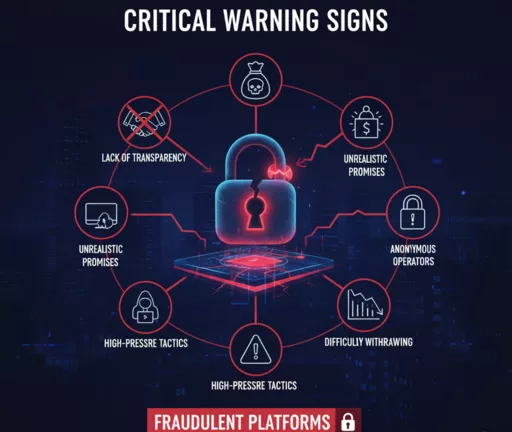The cryptocurrency market’s volatility attracts platforms promising exponential returns through extreme leverage often advertising “30x” gains that sound impossibly attractive. These promises tap into fundamental human desires for rapid wealth accumulation, but the mathematical realities of leveraged trading tell a dramatically different story. Before considering any high-leverage cryptocurrency platform, understanding how leverage actually works, recognizing common scam indicators, and evaluating genuine alternatives becomes essential for protecting your capital and making informed financial decisions.
Decoding Leverage: The Double-Edged Sword of Amplified Trading
Leverage allows traders to control positions significantly larger than their actual capital by borrowing funds from the platform or other users. While this mechanism exists legitimately in traditional finance and regulated cryptocurrency exchanges, extreme leverage ratios present risks that even experienced traders struggle to manage effectively.
The Mathematics of 30x Leverage
When a platform offers 30x leverage, your initial capital controls a position thirty times larger than your actual investment. This multiplication applies equally to both gains and losses the critical detail many novice traders overlook.
Practical Leverage Calculation:
| Your Capital | Leveraged Position (30x) | Price Move Against You to Lose Everything |
|---|---|---|
| $100 | $3,000 | 3.33% decline |
| $500 | $15,000 | 3.33% decline |
| $1,000 | $30,000 | 3.33% decline |
| $5,000 | $150,000 | 3.33% decline |
Step-by-Step Example with $100:
- Your $100 stake controls a $3,000 position (100 × 30 = 3,000)
- The cryptocurrency price declines by 3.33%
- Your $3,000 position loses $100 (3,000 × 0.0333 = 100)
- Your entire stake is eliminated through liquidation
- You have $0 remaining, plus potentially owe additional fees
This calculation demonstrates why 30x leverage is extraordinarily dangerous: cryptocurrency markets routinely experience 3-5% price swings within minutes, making position liquidation not just possible but probable during normal market volatility.
Why Extreme Leverage Favors the Platform
High-leverage trading generates substantial revenue for platforms through multiple mechanisms that consistently work against traders:
Trading Fees: Each position opening and closing incurs fees, typically 0.02-0.1% per trade. With leverage encouraging frequent trading and rapid liquidations, these fees accumulate quickly.
Funding Rates: Leveraged positions often incur periodic interest charges (funding rates) that erode capital even when prices remain stable.
Liquidation Penalties: When positions liquidate, platforms charge additional fees while capturing the remaining margin often 0.5-1% of position size.
Spread Manipulation: Less reputable platforms may widen bid-ask spreads during volatility, accelerating liquidations and increasing their profits.
These mechanisms mean that even if you correctly predict market direction, fees and funding costs can prevent profitability. The platform profits regardless of whether traders win or lose a business model that incentivizes maximizing trading volume rather than trader success.
Platform Evaluation: Due Diligence for Cryptocurrency Services
Before committing capital to any cryptocurrency platform particularly those offering extreme leverage systematic evaluation across multiple dimensions protects against fraud and operational risks.
Regulatory Compliance and Licensing
Legitimate cryptocurrency trading platforms operate under financial regulatory oversight from recognized authorities. This licensing provides legal recourse if disputes arise and ensures minimum operational standards.
Recognized Regulatory Bodies:
| Authority | Jurisdiction | Significance |
|---|---|---|
| Financial Conduct Authority (FCA) | United Kingdom | Strict cryptocurrency regulation, requires registration |
| Securities and Exchange Commission (SEC) | United States | Oversees securities, increasingly active in crypto |
| Commodity Futures Trading Commission (CFTC) | United States | Regulates derivatives and futures, including crypto |
| Australian Securities and Investments Commission (ASIC) | Australia | Requires licensing for crypto derivatives |
| Financial Services Agency (FSA) | Japan | Comprehensive crypto exchange licensing |
Verification Process:
- Check platform’s legal entity name and registration location
- Visit the relevant regulatory authority’s website
- Search their database for the platform’s license
- Verify license status is current and active
- Confirm permitted activities match platform offerings
Unlicensed platforms operating in regulated jurisdictions face legal action, potential asset seizures, and abrupt shutdowns leaving user funds inaccessible. If you cannot verify licensing, assume the platform operates illegally.
Team Transparency and Operational History
Legitimate financial services proudly display leadership teams, operational history, and corporate information. Anonymous or pseudonymous operators present unacceptable risk for financial platforms.
Essential Transparency Indicators:
- Named executives: Full names, professional backgrounds, and verifiable career histories
- LinkedIn profiles: Active, established professional networks for key personnel
- Company registration: Verified corporate entity with accessible public records
- Physical address: Real office locations, not virtual mailboxes or PO boxes
- Contact information: Working phone numbers and responsive customer support
- Public appearances: Team members participating in industry conferences or media interviews
Fraudulent platforms deliberately obscure identity to avoid accountability. If you cannot identify who controls the platform, you cannot hold anyone responsible when problems arise.
Security Infrastructure Assessment
Cryptocurrency platforms become prime targets for hackers due to the concentrated digital assets they hold. Robust security measures are non-negotiable for protecting user funds.
Mandatory Security Features:
Two-Factor Authentication (2FA): Requires second verification step beyond passwords, dramatically reducing account compromise risk. Platforms should support authenticator apps (Google Authenticator, Authy) rather than SMS-based 2FA vulnerable to SIM swapping attacks.
Cold Storage: Majority of platform assets (typically 90-95%) should remain in offline wallets inaccessible to hackers. Platforms should explicitly disclose cold storage percentages and policies.
Withdrawal Whitelisting: Ability to pre-approve withdrawal addresses with time delays for new addresses prevents immediate fund theft if accounts are compromised.
Insurance Coverage: Some platforms maintain insurance policies covering user funds in case of platform hacks or operational failures.
Security Audits: Third-party security assessments from reputable firms (CertiK, Trail of Bits, Quantstamp) demonstrate commitment to identifying and addressing vulnerabilities.
Platforms lacking these basic protections place user funds at unnecessary risk regardless of their trading features or promised returns.
User Experience and Withdrawal Testing
Many fraudulent platforms operate smoothly during deposit phases but create obstacles when users attempt withdrawals the critical moment revealing their true nature.
Withdrawal Verification Process:
- Deposit a small test amount (minimum allowed)
- Complete a minimal trade or simply hold briefly
- Attempt immediate withdrawal to external wallet
- Document the entire process with screenshots
- Note processing time against platform’s stated timeframe
- Verify funds arrive without unexpected deductions
Withdrawal Red Flags:
- Withdrawal requests remain “pending” for days without explanation
- Platform suddenly requires additional verification documents
- Minimum withdrawal amounts set impossibly high
- Unexpected fees consuming significant portions of withdrawals
- Technical errors consistently preventing withdrawal completion
- Support becoming unresponsive after withdrawal requests
These tactics allow fraudulent platforms to retain deposits while creating plausible excuses for non-payment. Never deposit substantial amounts without first successfully testing the withdrawal process.
Critical Warning Signs of Fraudulent Platforms

Certain characteristics consistently appear across cryptocurrency scams and fraudulent platforms. Recognizing these patterns prevents costly mistakes.
Unrealistic Return Guarantees
No legitimate trading platform cryptocurrency or traditional finance can guarantee specific returns. Market movements are inherently unpredictable, and any claims of assured profits indicate either fraud or fundamental misunderstanding of financial markets.
Fraudulent Promise Examples:
- “Guaranteed 30x returns on every trade”
- “Zero-risk trading with protected capital”
- “Our AI never loses trades”
- “Minimum 10% daily profits guaranteed”
- “Risk-free leveraged trading strategies”
Legitimate platforms clearly disclose that trading involves substantial risk of capital loss and provide detailed risk warnings rather than profit guarantees. Regulatory requirements in developed markets explicitly prohibit guarantee-based marketing for volatile financial instruments.
Brand Confusion and Name Similarity
Fraudulent platforms frequently adopt names resembling established, reputable projects to exploit brand recognition and create false legitimacy through association.
Example Pattern: A platform using “Ocean” in its name might attempt to piggyback on Ocean Protocol’s reputation a legitimate decentralized data exchange network despite having no actual connection. This tactic relies on less-informed users assuming relationships that don’t exist.
Verification Requirements:
- Check official websites and social media accounts of established projects
- Look for explicit partnership announcements from both parties
- Verify through blockchain explorers if platforms share contract addresses
- Search for press releases or official statements confirming relationships
- Contact official support channels of established projects to verify affiliations
Legitimate partnerships are always publicly announced through official channels. If you cannot find confirmation, assume no relationship exists regardless of naming similarities.
Referral-Heavy Business Models
While referral programs exist in legitimate services, platforms where recruitment becomes the primary profit mechanism for users often disguise Ponzi or pyramid schemes as trading platforms.
Ponzi Scheme Indicators:
- Returns primarily funded by new member deposits rather than actual trading profits
- Complex tier systems rewarding recruitment over trading activity
- Withdrawal restrictions easing for users who recruit additional members
- Platform sustainability depending on continuous growth rather than operational revenue
- Emphasis on team-building and networking over actual trading education
These structures inevitably collapse when recruitment slows, with recent participants losing their entire investment. The platform operators profit during growth phases before disappearing when sustainability becomes impossible.
Manufactured Social Proof
Fraudulent platforms create illusions of legitimacy through fabricated testimonials, fake reviews, and purchased social media engagement.
Identifying Fake Reviews:
- Generic praise lacking specific details or experiences
- Reviews posted in clusters over short timeframes
- Overly perfect ratings without any critical feedback
- Testimonials using stock photos or celebrity images
- Reviewer profiles with minimal history or suspicious patterns
- Positive reviews contradicting experiences shared in independent forums
Cross-reference claims through established, independent platforms like Trustpilot, Reddit cryptocurrency communities, and BitcoinTalk forums where scam accusations typically surface quickly from affected users.
The “Ocean” Branding Question: Distinguishing Projects
The cryptocurrency space includes Ocean Protocol a legitimate, established project focused on decentralized data marketplaces with its native OCEAN token. This project operates transparently with:
- Verifiable team members and advisors from data science and blockchain sectors
- Regular development updates on public GitHub repositories
- Trading availability on major exchanges (Binance, Coinbase, Kraken)
- Clear documentation of technology, tokenomics, and use cases
- Active partnerships with data-focused enterprises and research institutions
Any platform incorporating “Ocean” in its name without explicit, verifiable connection to Ocean Protocol should be approached with extreme caution. Crypto30X.com and similar sites may deliberately choose confusing names to exploit brand recognition while operating independently often without the legitimacy of the projects they reference.
Verification Steps:
- Visit Ocean Protocol’s official website and social media accounts
- Check their official partnerships page for listed collaborators
- Search their announcements for mentions of the platform in question
- Look for disclaimers about unauthorized use of their branding
- Contact Ocean Protocol support directly to verify relationships
Established projects actively combat brand confusion and typically publish warnings when fraudulent platforms misappropriate their names or branding.
Safer Cryptocurrency Investment Alternatives
Investors seeking cryptocurrency exposure without extreme leverage risks have numerous alternatives providing more reasonable risk-reward profiles.
Long-Term Holding Strategy
Purchasing established cryptocurrencies and holding them through market cycles (commonly called “HODLing” in crypto communities) provides market exposure without leverage risk or liquidation danger.
Strategic Holding Approach:
- Bitcoin (BTC): Digital gold narrative, fixed supply of 21 million coins, longest operational history
- Ethereum (ETH): Smart contract platform dominance, extensive developer ecosystem, ongoing protocol improvements
- Diversified Portfolio: Allocation across multiple established projects reduces single-asset risk
Dollar-cost averaging systematic purchases of fixed dollar amounts regardless of price mitigates timing risk and eliminates pressure to predict short-term price movements. This strategy performed well historically despite cryptocurrency’s extreme volatility.
Staking and Proof-of-Stake Rewards
Proof-of-Stake blockchains reward users who lock tokens to support network operations, generating passive income without trading or leverage exposure.
Popular Staking Options:
| Cryptocurrency | Average Annual Yield | Lock-up Period | Risk Level |
|---|---|---|---|
| Ethereum (ETH) | 3-5% | Flexible or fixed | Low (established network) |
| Cardano (ADA) | 4-6% | None (withdraw anytime) | Low-Medium |
| Solana (SOL) | 6-8% | Minimal (epoch-based) | Medium (newer network) |
| Polkadot (DOT) | 10-14% | 28 days unbonding | Medium |
| Cosmos (ATOM) | 15-20% | 21 days unbonding | Medium-High |
Staking carries risks including:
- Price volatility of the staked asset potentially exceeding earned rewards
- Lock-up periods preventing selling during market declines
- Smart contract vulnerabilities in some staking protocols
- Validator slashing penalties for node misbehavior (though typically minimal for delegators)
However, these risks pale compared to 30x leverage liquidation danger. Staking generates returns from protocol inflation and transaction fees rather than speculative trading.
Decentralized Finance (DeFi) Participation
DeFi protocols enable lending, borrowing, and liquidity provision without centralized intermediaries, though understanding the unique risks becomes essential.
DeFi Investment Options:
Lending Protocols: Platforms like Aave and Compound allow depositing cryptocurrency to earn interest from borrowers. Returns fluctuate based on supply and demand but typically range from 1-10% annually for stablecoins and major cryptocurrencies.
Liquidity Providing: Automated market makers (AMMs) like Uniswap reward users who deposit paired assets to facilitate trading. Returns include transaction fee shares but carry “impermanent loss” risk potential underperformance versus simple holding.
Yield Aggregators: Services like Yearn Finance automatically optimize returns across DeFi protocols, though additional smart contract layers increase complexity and risk.
DeFi Risk Considerations:
- Smart contract vulnerabilities enabling hacks (historically resulting in billions in losses)
- Impermanent loss reducing returns during volatile markets
- Protocol governance changes affecting terms
- Gas fees on Ethereum potentially consuming small account returns
- Regulatory uncertainty surrounding DeFi’s legal status
DeFi participation requires technical understanding and risk acceptance but offers control over assets unlike centralized platforms where third parties maintain custody.
Traditional Equity Exposure to Cryptocurrency
Investors seeking regulated exposure to cryptocurrency markets without directly holding digital assets can invest in publicly-traded companies with significant crypto involvement.
Crypto-Exposed Equities:
- Coinbase (COIN): Major cryptocurrency exchange, revenue correlated with trading volume
- MicroStrategy (MSTR): Business intelligence company holding substantial Bitcoin treasury
- Block (SQ): Payment processor with significant Bitcoin holdings and services
- Marathon Digital (MARA): Bitcoin mining operations
- Riot Platforms (RIOT): Bitcoin mining and hosting services
These investments provide cryptocurrency price exposure through traditional brokerage accounts with regulatory protections, though company-specific risks and less direct price correlation apply.
Understanding Leverage Mechanics: The Critical Math
Before considering any leveraged trading, understanding the precise mathematical relationship between leverage ratio, margin requirements, and liquidation thresholds prevents catastrophic losses.
Margin and Maintenance Requirements
Initial Margin: The percentage of position value you must deposit. With 30x leverage, initial margin equals 3.33% (1 ÷ 30 = 0.0333).
Maintenance Margin: The minimum margin percentage required to keep positions open. When your margin falls below this threshold, liquidation occurs. Platforms typically set maintenance margin at 1-2%.
Liquidation Price Calculation:
For a long position (betting on price increase) with 30x leverage:
Liquidation Price = Entry Price × (1 – Initial Margin + Maintenance Margin)
Example:
- Entry Price: $50,000 (Bitcoin)
- Initial Margin: 3.33%
- Maintenance Margin: 1%
- Liquidation Price: $50,000 × (1 – 0.0333 + 0.01) = $48,835
A mere $1,165 decline (2.33%) triggers complete position liquidation, eliminating your capital plus charging liquidation fees.
Cumulative Impact of Fees and Funding
Leverage trading involves multiple cost layers beyond simple price movement:
Trading Fees: 0.02-0.1% per transaction (opening and closing positions) Funding Rates: Periodic interest charges, typically 0.01-0.1% per 8 hours Liquidation Fees: 0.5-1% of position value when positions close involuntarily
Total Cost Example (30-day leveraged position):
- Opening fee: $3,000 × 0.05% = $1.50
- Funding rate (3 times daily): $3,000 × 0.03% × 90 = $81
- Closing fee: $3,000 × 0.05% = $1.50
- Total costs: $84
With a $100 initial stake, fees consume 84% of capital before considering price movements. The position must gain 84% just to break even requiring a 2.8% favorable price movement (84% ÷ 30x leverage).
This mathematical reality explains why most leveraged traders lose money regardless of market prediction accuracy. Source
Recognizing and Avoiding Cryptocurrency Scams
The cryptocurrency industry’s rapid growth, technological complexity, and limited regulation create conditions where fraud flourishes. Recognizing common scam patterns protects capital.
Investment Scheme Categories
Ponzi Schemes: Early investors receive returns from new investor deposits rather than actual profits, creating unsustainable models inevitably collapsing. BitConnect’s 2018 collapse lost investors over $2 billion.
Exit Scams: Platforms operate legitimately initially before suddenly shutting down and absconding with user funds. QuadrigaCX’s 2019 collapse resulted in $190 million in missing customer funds.
Pump and Dump: Coordinated groups artificially inflate low-volume cryptocurrency prices through hype before selling holdings, leaving later buyers with worthless assets.
Phishing and Social Engineering: Fake websites, emails, or social media accounts impersonate legitimate services to steal login credentials or private keys.
Fake Initial Coin Offerings (ICOs): Fraudulent token sales collecting investment for non-existent projects before disappearing.
Rug Pulls: DeFi projects where developers drain liquidity pools after attracting investment, particularly common in anonymous decentralized exchange listings.
Protective Measures and Best Practices
Research Verification Checklist:
- Google search “[Platform Name] scam” and “[Platform Name] review”
- Check Reddit r/CryptoCurrency and r/CryptoScams for discussions
- Search BitcoinTalk forums for platform mentions
- Verify all claims through independent sources
- Never trust information solely from the platform itself or its affiliates
Investment Decision Framework:
- If promises seem too good to be true, they invariably are
- Demand evidence for all claims rather than accepting marketing materials
- Prioritize capital preservation over potential gains
- Allocate only amounts you can afford to lose completely
- Diversify across multiple projects and strategies
- Maintain emotional discipline during FOMO (fear of missing out)
Conclusion: Informed Decisions Over Impulsive Speculation
High-leverage cryptocurrency trading platforms marketing “30x” returns exploit natural human tendencies toward optimism bias and recency bias overestimating the probability of positive outcomes while downplaying risks based on recent successes. The mathematical realities of extreme leverage combined with cryptocurrency’s inherent volatility create conditions where even sophisticated traders struggle to maintain profitability.
Before considering any platform offering extreme leverage:
- Verify regulatory licensing and compliance
- Confirm team transparency and operational history
- Test security measures and withdrawal processes
- Calculate the precise leverage mathematics and liquidation thresholds
- Account for cumulative fees reducing effective returns
- Research independent user experiences across multiple sources
For most investors, safer alternatives long-term holding of established cryptocurrencies, staking rewards, carefully researched DeFi participation, or traditional equity exposure provide cryptocurrency market access without catastrophic loss risks inherent to extreme leverage.
The cryptocurrency industry offers genuine innovation and investment opportunities, but distinguishing legitimate projects from fraudulent schemes requires skepticism, thorough research, and realistic expectations. Platforms that cannot withstand scrutiny don’t deserve your capital regardless of promised returns.
Protect your financial future by prioritizing education over speculation, verification over trust, and long-term strategy over short-term gambling. The most valuable investment you can make is in your own understanding knowledge that serves you across all financial decisions, far beyond any single trade or platform.
CRITICAL WARNINGS:
Leveraged trading involves substantial risk of loss exceeding your initial investment. Never trade with borrowed money or funds needed for essential expenses. This article provides educational information only and does not constitute financial advice or endorsement of any platform. Conduct independent research and consult qualified financial advisors before making investment decisions. The author and publisher assume no liability for financial losses resulting from information presented herein.
If you encounter suspected cryptocurrency fraud, report it to:
- FBI Internet Crime Complaint Center (IC3): www.ic3.gov
- Federal Trade Commission (FTC): reportfraud.ftc.gov
- Securities and Exchange Commission (SEC): www.sec.gov/tcr
- Local financial regulatory authorities












